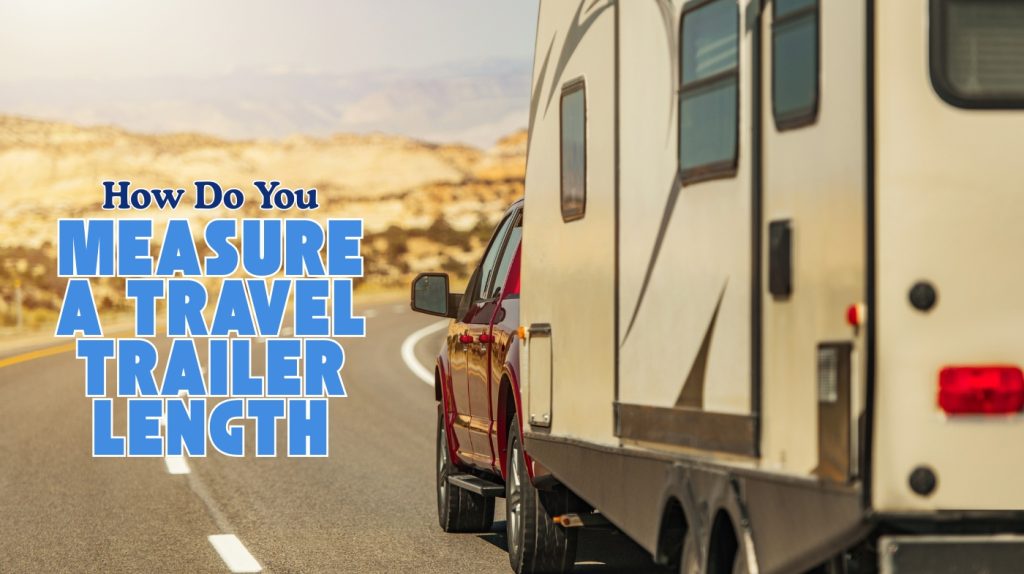Last Updated on August 3, 2025
To measure your travel trailer length, start at the front edge of the hitch coupler and extend the tape measure to the trailer’s rearmost point, including the bumper and any permanent fixtures like bike racks or propane tanks.
This overall length reflects your full towing footprint, vital for safe driving, parking, and legal limits. Remember, trailer manufacturers sometimes list just the box length, which excludes hitch and bumper, so knowing how to measure properly helps avoid surprises.
Keep exploring for a deeper understanding of length components and measurement techniques.
Key Takeaways
- Measure from the front edge of the hitch coupler to the rearmost point of the trailer, including bumpers and permanent fixtures.
- Use a tape measure along the trailer’s side on level ground, ideally 25+ feet long for accuracy.
- Confirm whether the measurement includes only the box length or the overall length with hitch and accessories.
- Take multiple measurements and average them to reduce errors and ensure consistency.
- Verify measurements against manufacturer specs to understand if lengths reflect interior space or total footprint.
Travel Trailer Length Components
When measuring a travel trailer’s length, you need to account for more than just the main living area the hitch or kingpin at the front plays a critical role in the total length calculation.
Choosing tires with the correct load capacity is equally important to support the trailer’s weight safely. The total length includes the front hitch type: a traditional drawbar hitch for most travel trailers or a kingpin for fifth wheels.
Note that manufacturers often list “box length,” which excludes the hitch and bumper, so the actual physical length can surpass model designation by several feet.
Front-mounted fixtures like bike racks or propane tanks usually don’t count toward length measurements since they don’t affect towing dimensions.
Understanding these components ensures you grasp the true trailer size, which is critical for safe towing, parking, and legal compliance. Proper measurements ensure maneuverability and fit at campsites and on the road.
Common Methods for Measuring Trailer Length
Although measuring a travel trailer’s length might seem straightforward, it requires adherence to industry standards to guarantee accuracy. You should measure from the leading front edge of the hitch coupler to the rearmost extremity, including the bumper or rear wall.
Avoid including manufacturer-defined appurtenances to maintain consistency. According to RV Industry Association rules, the measurement must exclude certain excluded items such as door latches, exterior ladders, and spare tires to ensure uniformity.
Measure travel trailers from the hitch coupler’s front edge to the rear bumper, excluding additional appurtenances.
When measuring, use a tape measure along the trailer’s side and confirm whether the hitch is included in your measurement. Consider weight capacity when selecting accessories like spare tire mounts, as improper support can affect trailer safety.
Common methods include:
- Measuring from hitch coupler front to trailer rear bumper or wall
- Using manufacturer specifications for overall length verification
- Cross-referencing length data with RV Industry Association labeling requirements
- Distinguishing between exterior, interior, and overall lengths for compliance
Differences Between Box Length and Overall Length
You need to understand that box length measures only the trailer’s main body, excluding the hitch and bumper extensions. Batteries with different capacity and power needs can affect how you calculate the total weight for towing.
Overall length includes everything from the front of the hitch to the rear-most accessory, which directly affects towing and parking requirements. Considering factors like battery weight and dimensions is important for ensuring safe and efficient vehicle operation.
Knowing both lengths helps you plan accurately for safe maneuvering and campsite restrictions. Since no standardized rules exist for model numbers or length indicators in trailers, relying solely on the model number can be misleading.
Definition of Box Length
Since box length measures only the main enclosed body of a travel trailer, it excludes external components like the hitch, tongue, and bumper that contribute to the overall length. This measurement focuses strictly on the trailer’s living area, providing a clear sense of interior space without considering protrusions.
Proper maintenance, including protection against water damage with waterproofing sprays, can help preserve the trailer’s condition over time.
When you evaluate box length, keep in mind:
- It’s typically shorter than overall length by several feet
- Box length often appears in manufacturer model numbers but isn’t standardized
- It helps assess usable living space and interior layout planning
- Box length excludes towing and parking footprint considerations
Verify both box length and overall length measurements since manufacturers use different methodologies, and there is no universal standard. Understanding box length lets you gauge the cabin size precisely, but remember, it doesn’t reflect the total space your trailer occupies when hitched or parked.
What Overall Length Includes?
While box length provides a clear measure of the trailer’s interior living space, overall length captures the entire physical footprint, including the front tongue and rear bumper.
This full measure is essential for practical planning since it accounts for all fixed attachments, unlike box length, which excludes the tongue and bumpers. For example, a model named for a 17-foot box length may actually measure about 21 feet overall.
The manufacturer’s website is a reliable source to verify these measurements for specific models. Considering installation ease when measuring is important, as some RV components require precise space allowances.
| Aspect | Box Length | Overall Length |
|---|---|---|
| Definition | Interior living space length | Front of tongue to rear bumper |
| Usage | Model identification | Parking, storage, and campsite sizing |
| Typical Difference | Excludes tongue and bumper | Includes tongue and bumper (adds ~3-4 ft) |
Impact on Towing and Parking
Although trailer box length provides a convenient reference, the overall length, including the hitch and tow vehicle has a far greater impact on towing regulations, maneuverability, and parking requirements.
You must account for the combined length to conform with state limits, which often cap total rigs at 65 feet. Ignoring the tow vehicle and hitch length risks violating legal limits, complicating tight turns, and causes parking issues.
Additionally, most states set maximum lengths for motorhomes between 40-45 ft, which is crucial when combining towing setups to avoid exceeding legal length limits. Choosing equipment such as a winch with the proper weight capacity can further ensure safe and efficient trailer handling.
For safe and lawful travel, consider these critical factors:
- Total combined length affects turning radius and trailer sway control
- Parking spots and storage spaces require the full rig length, not just box size
- Roadway restrictions apply to overall length, influencing route selection
- Safety equipment requirements depend on trailer size and weight related to length
Tools and Techniques for Accurate Measurement
You’ll want to start with a reliable measuring tape, ideally 25 feet or longer, to capture the full length accurately. Measure from the furthest front point of the hitch to the rear bumper, including any fixed accessories that affect overall length.
Ensuring your measurement accounts for tire size is also important, as it can influence the total length and clearance. This method guarantees your measurement reflects the actual space your trailer occupies, which is essential for towing and parking.
For the most accurate measurement, refer to the manufacturer specifications as they provide standardized length data that ensures consistency across models.
Measuring Tape Usage
When measuring your travel trailer’s length, selecting the right tape and mastering proper techniques guarantees accuracy and reliability. Choose a high-quality measuring tape at least 30-35 feet long to reach from the hitch to the bumper seamlessly.
Hold the tape taut and parallel to the ground to prevent sagging or angular distortion. Employ a helper to keep the tape steady at one end, ensuring a straight line. Mark critical points with chalk or tape for consistent reference.
Verify the total length from reliable sources like manufacturer brochures or official websites to avoid surprises caused by length variances. Additionally, using precision tools can significantly improve measurement accuracy for complex trailer designs.
Key tips include:
- Start at the front edge of the hitch, excluding removable fixtures.
- Measure to the rear edge of the bumper or permanent storage racks.
- Take multiple measurements to average out errors.
- Record in consistent units and note any slide-outs or extensions.
Hitch vs Bumper
Accurately gauging your travel trailer’s length requires understanding the distinct roles of the hitch and bumper as reference points. The hitch coupler marks the foremost point, capturing the full towing length, while the rear bumper defines the trailer’s end.
Measuring from hitch to bumper ensures you include all necessary length for towing safety, legal compliance, and parking. Use tools like measuring wheels or laser distance measurers on level ground for precision.
For consistent and reliable results, it is recommended to perform measurements in a temperature-controlled environment to prevent expansion or contraction of materials affecting accuracy, a concept similar to proper battery storage conditions.
Always verify measurements against manufacturer specs to avoid confusion between body length and total length. Note that many trailers are measured from hitch to rear bumper, with some subtracting about 3 ft to find the cargo or body length.
Importance of Precise Length Measurement
Although measuring the length of a travel trailer might seem straightforward, getting this measurement precisely right is critical for several reasons. You must guarantee legal compliance with state and federal size limits, avoid costly fines, and prevent restricted access to roads or campgrounds.
Accurate measurement also impacts towing safety by influencing weight distribution, stability, and equipment selection. Additionally, precise length data helps you navigate tight spaces and fit your trailer into designated parking or storage areas without issues.
Choosing equipment with the appropriate flow and pressure capabilities is essential to maintain water system performance on the trailer.
- Ensures adherence to legal size limits, preventing fines and permit complications
- Aids in maneuvering through campsites, driveways, and narrow roads safely
- Influences towing dynamics, including sway control and proper hitch setup
- Enables purchase of correctly fitting covers and maintenance equipment
Precision in length measurement protects your investment and guarantees safe, compliant travel. When measuring travel trailers, measure the body length from the front bumper to the rear bumper, excluding the hitch or tongue, to get an accurate representation of the trailer’s main structure size.
Interpreting Manufacturer Specifications and Model Numbers
Since manufacturer specifications and model numbers can vary widely, you need to understand exactly what these figures represent to interpret travel trailer lengths correctly.
Model numbers often reflect the body or interior living space length, excluding the hitch and bumper, but some include approximate overall length. For example, a brochure listing a 26-foot model may actually measure 31 feet overall.
Manufacturers differ in what components they include most measurements from the front of the hitch to the rear bumper, but some exclude bumper overhang or hitch length. Slide-outs and extensions never factor into static length.
Always verify lengths via manufacturer specs, physical measurements, or trusted databases. Knowing these nuances guarantees accurate towing, parking, and accessory decisions, preventing costly mistakes related to length misinterpretation.
Remember that the recommended maximum trailer length is generally 27 feet, but state park restrictions and towing requirements may vary significantly.
Frequently Asked Questions
How Does Trailer Length Affect Towing Vehicle Requirements?
Trailer length directly impacts your towing vehicle’s capacity and equipment needs. Longer trailers usually weigh more, so you’ll need a vehicle with a higher Gross Combined Weight Rating (GCWR) and stronger brakes.
You might also require upgraded suspension and hitch reinforcements to handle the extra stress. Additionally, longer trailers can reduce maneuverability, demanding more engine power and stability control from your tow vehicle to maintain safe, compliant towing on varied roads.
What Are Common Legal Length Limits for Travel Trailers?
Imagine roads as gates with length limits you must respect. Most states cap travel trailers between 28 to 40 feet, with common limits at 28, 30, or 32 feet.
National parks often trim that to around 27 or 28 feet. Remember, some states like Texas allow up to 48 feet, while others restrict more. Always check local laws before you hit the road to avoid fines or denied access.
How Do Roof Accessories Impact Trailer Height Measurements?
You must include roof accessories like air conditioners, antennae, and storage boxes when measuring trailer height. These add to the base roof height, affecting clearance under bridges and overpasses. Ignoring them risks damage and legal trouble since they can push your trailer above height limits.
Measure each accessory separately and add its height to your trailer’s base height for accurate clearance data. This ensures safe travel and proper route planning.
Can Trailer Length Influence Campground Reservation Options?
Yes, trailer length definitely influences your campground reservation options. Many parks set maximum length limits for individual sites, sometimes including your tow vehicle. If your trailer is too long, you might be restricted from popular sites or entire campgrounds with strict size policies.
Knowing your exact trailer length helps you select suitable sites and avoid last-minute issues like site denial or inconvenient relocations upon arrival. Always check length limits before booking.
Are There Differences in Length Measurement Between Travel Trailers and Fifth Wheels?
Yes, you’ll find key differences measuring travel trailers versus fifth wheels. Travel trailers are measured from the hitch ball coupler to the rear bumper. Fifth wheels use the kingpin to rear bumper.
Fifth wheels’ neck extends into the truck bed, complicating total length. Model numbers may reflect either the living area or overall length for both, but measurement methods vary.
Start from the Hitch: The Right Way to Use a Tape Measure
Now that you know how to measure every vital inch of your travel trailer—from box length to overall length—you’re just one step away from making confident decisions.
But here’s the catch: misjudging even a few inches can cost you on the road or at the campsite. Don’t leave it to chance. Use the right tools, double-check your measurements, and trust the details. Your perfect adventure depends on it.



